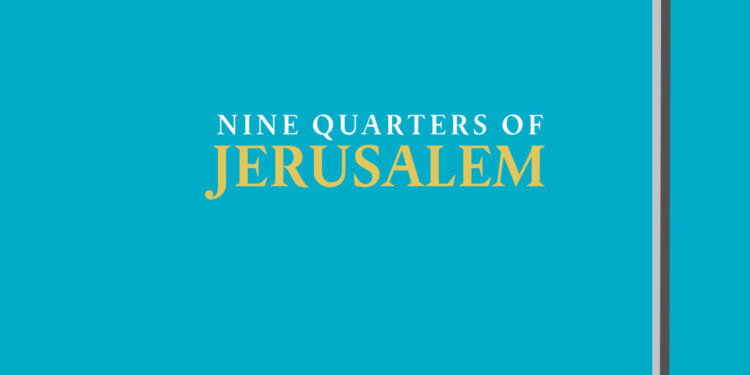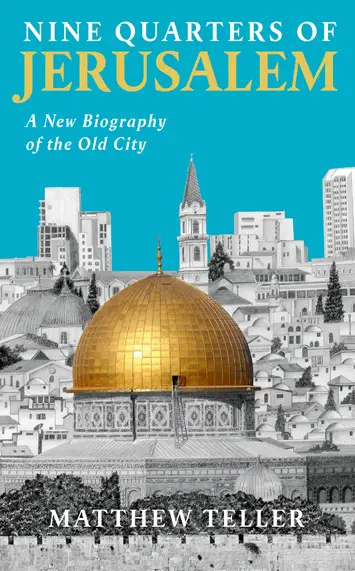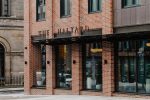Nine Quarters of Jerusalem by Matthew Teller – Review

By Clare Jenkins
Matthew Teller’s experiences of Jerusalem go back more than 40 years, to a family holiday in Israel when he was 11. “The memory of walking through the spice market for the first time remains strong,” he writes. “Even today, the smell of cumin takes me straight back there.”
Since then, he has become a journalist, travel writer (including five Rough Guides) and BBC producer/presenter, covering wide swathes of the Middle East, living in Jordan and Egypt, and revisiting Jerusalem countless times. As he says at the start of this exhaustively researched book: “Jerusalem is not my city and never will be. That said, there has hardly been a year in my life in which it has not played a part.”
Of Jewish ancestry himself – all eight great-grandparents were Jews who migrated to Britain from Poland and different regions of Russia – he nonetheless sees himself as an onlooker: “By Israel’s criteria I’m in and always have been. By mine, though, which are much more important, I’m as much of an outsider in Jerusalem as I ever was, but at least I’m no longer a stranger.”
The city, with its many and varied communities hidden behind walls, down alleyways, within and outside the bewildering array of religious and secular buildings, has always fascinated him. He quotes the ‘Jerusalemite author’ John Tleel saying, “Only by living inside the Old City, enclosed by its walls, can you really come to know Jerusalem.”
And it’s that walled Old City he concentrates on here – not just its multi-layered, conflict-ridden past, but its equally kaleidoscopic present. So this ‘biography of a city’ is seen through the eyes of historic characters and current inhabitants –and not just Jewish and Palestinian ones. His scope takes in the experiences of Armenians, Greeks, Syriacs; Dom gypsies, Islamic Sufi mystics (a fascinating chapter) and Roman Catholic priests; those with Moroccan, African and Indian heritage.
Each person has a story to tell, of course, and Teller’s professed aim is “to amplify Jerusalemite voices, help them to be heard above the clamour”. Yet this is not an oral history – in fact, at times, the voices are muffled by the weight of historical detail and the detachment of indirect prose.
So we learn – comprehensively – about Jerusalem’s heartbreakingly complicated history, the various power players who have sought to rule it, divide it, carve it up.
 “No stone is unturned”
“No stone is unturned”
We learn – extensively – about past and present tensions, placements and displacements, inequalities and paranoias, the checkpoints guarded by armed police, the NGOs that try to help the poor and undervalued, the saints and the sex workers (well, there’s just one of those, and she was 13th Century).
We learn that it has not just four quarters – Christian, Muslim, Armenian and Jewish – but nine. We learn about the blurred overlapping of those ‘quarters’, in both physical and human terms. We learn (or so it seems) about every gate, souk, ‘brand’ (the Via Dolorosa, Church of the Holy Sepulchre, Garden Tomb aka Golgotha), church/mosque/synagogue, and tomb.
A friend who lives there asks him what he thinks of the city. “How to reply? You could say it looks beautiful or tense, or ugly or calm, or inspiring, or smelly, or hopeless, and it would all be true.” Later, he says: “Vendors of highest quality snake-oil may laud Jerusalem’s all-encompassing holiness and eternality, but take away the Old City and you’re left with an overgrown provincial hill-town, and not an especially pretty one at that.”
Yet residents of – and visitors to – that Old City find a strange, strong pull to the place. Hence the designation of ‘Jerusalem Disorder’ – “in which visiting Jerusalem triggers obsessive religious delusions”. Some inhabitants, too, have a passionate, sometimes debilitating, sense of history, both of their own existence in Jerusalem and of their ancestral home and connections.
“If you take a fish from the sea it will die. Jerusalem is my sea. I can’t live outside it,” says Afro-Palestinian journalist Musa Qous. Or, as al-Shaima al-Budeiri, matriarch of one of Jerusalem’s grand families, puts it: “I feel with the souls of my grand-grand-fathers. All the stones of the Old City speak with me. When I leave Jerusalem, when I leave Palestine, I am nothing, I feel nothing. When I come back, I am everything.”
While this is an awesome book, I would have liked to hear more – in their own words – from such people; from the tailors, coffee-roasters and halawa bakers, the social activists, ceramicists and cat-lovers, the sellers of silk and books, the “warriors for education” and other community workers. (And from the Little Sisters of Jesus, only fleetingly mentioned, but whose stories, I know, can be inspiring). I’d have liked to hear more from them about the appeal of the city, its beauty, its sometimes fatal attraction.
Instead, because the historical coverage is so thorough – no stone is unturned here in the quest to discover where that stone came from, who hacked it out of the earth, who laid it inside Jerusalem and why – their voices do sometimes still struggle to be heard.
‘Nine Quarters of Jerusalem: A New Biography of the Old City’ by Matthew Teller is published by Profile Books, £16.99









